This was published 1 year ago
Sarah had 24 hours to abduct her own children or never see them again
The mother is the only Australian parent known to have won the child abduction race under Japan’s sole custody system, while a Canadian father sailed for 1000 kilometres to see his kids during pandemic lockdowns.
By Eryk Bagshaw and Natalie Clancy
Tokyo: The first time Australian mum Sarah realised something was amiss was when her Japanese husband suddenly started making food for the kids. The whiteboard in the kitchen had a message scrawled across it: “here’s your breakfast for the morning”.
Sarah found a bundle of documents between pillows on a couch. They contained details of grounds for divorce in Japan’s legal system, which gives one divorced parent sole custody of the couple’s children. “Not feeding the kids” was one of them.
Sarah - who asked to be identified by a pseudonym to protect her children’s welfare - was already alarmed after her husband set up separate bank accounts. The final clue set off a chain of events that would lead the Australian mother to abduct her own children.
“It was either that or have that done to me and I could never see the kids again,” she says.
Illustration:Credit: Matthew Absalom-Wong
Sarah sent her children to school in Tokyo and then went back to pick up as many clothes as she could in baskets while her husband slept. Within hours, she had told police she was removing the children and taking them to a secret location.
“I had an apartment straight away and had to change the kids’ schools while hiding our address,” she says.
Sarah considers herself lucky. She is the only known Australian parent to have won the parental abduction race in Japan.
The Sydney Morning Herald, The Age and 60 Minutes on Sunday revealed dozens of Australian parents and children have become the victims of child abduction in Japan. At least 82 Australian children have disappeared since 2004, never to be seen by their Australian parent again.
All of them had their children taken from them before they realised what was happening.
Sole custody system
In Japan, one parent has control over their child’s future after separation, including their education, healthcare and housing. Custody is regularly given to the parent who was last with the child, often regardless of their circumstances or ability to care for the kids after the end of a relationship.
The parent left behind has limited enforced visitation rights, or ability to see where their children are going to school, leading human rights groups to describe Japan as a “black hole” of international child abduction.
The Japanese government defends the system by arguing it protects women in vulnerable situations like Sarah, but she says she is burdened by the “massive guilt” of being forced into a race to take her kids.
“I’m giving him access to the children,” says Sarah. “They can see him whenever they like, but I don’t think it would have been the same if it was reversed.”
Sarah says she had no idea about Japan’s sole custody system until she found the divorce papers inside the couch.
“I was totally oblivious,” she says. “It was only because Catherine Henderson went through what she went through that I turned out OK.”
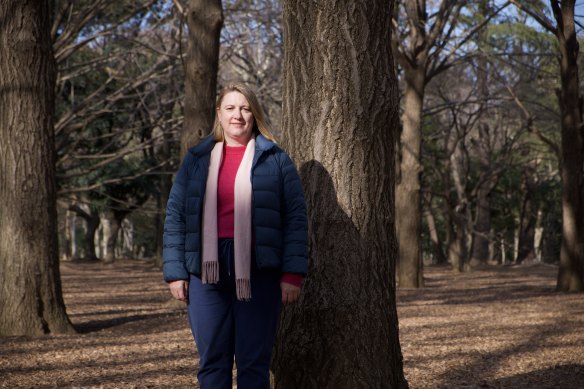
Melbourne mother Catherine Henderson has been fighting to get access to her two children since 2019.Credit: Ikkei Ben Suzuki
Henderson, 51, a Melbourne mother of two, has spent the past four years campaigning for changes to Japan’s century-old system, joining class actions and pulling together hundreds of parents from across the world grappling with similar situations. Her two children, then aged 10 and 14, were suddenly abducted in April 2019 by her husband. She has not been able to talk to them since.
“What have I done wrong to deserve not being able to have what everybody else takes for granted?” asks Henderson. “It’s devastating, frustrating and upsetting. It just never ends.”
Henderson told Sarah to sign a document at the district court that meant she could not be divorced without her knowledge. The divorce would have allowed her husband to apply for sole custody.
“What a crazy system,” says Sarah. “When I spoke to Catherine for the first time on the phone she told me: ‘I don’t want you to be in the same position that I am.’
“I don’t know how Catherine has done the things she has done. I probably would have curled up and died. Hopefully one day Catherine’s kids can look at her and say, ‘look at what mum did, she really fought for me’.”
A father’s journey across rough seas
Hundreds of other parents are fighting, too. Canadian Colin Rowat travelled 12,000 kilometres by air through a gauntlet of pandemic border closures and then 1000 kilometres by sea in the middle of typhoon season to try to see his kids in Tokyo.
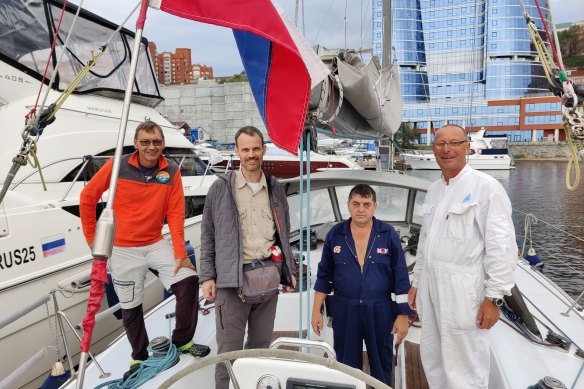
Canadian father Colin Rowat (second from left) sailed from Vladivostok to Fukuoka to see his children in Japan.
COVID-19 had largely sealed Japan’s borders and its visa system. Unlike many other parents, Rowat, who was then based in London, had a handful of visitation dates with his 15-year-old and 12-year-old kids in Tokyo but feared contact would be cut off if he did not make it to Japan.
“I was clinging on to this relationship,” says Rowat. “One finger gets broken at a time. And as you break the fingers, you just lose the grip and then eventually when all the fingers are broken there’s no longer any grip.”
Rowat pulled apart Japan’s border entry rules and found a loophole. Japan had stopped issuing visas to citizens of all but seven countries, one of which happened to be Canada.
Now the 50-year-old just needed to spend two weeks in a country that had not been banned by Japan. But none of those countries had flights to Tokyo.
“So I had to spend two weeks in ‘no country’,” he says. “What I needed to do is find the jurisdiction to which I could get to in the first place from which I could sail.”
Vladivostok, the former Russian military outpost, lies 1000 kilometres north of Japan. It also has a burgeoning sailing scene. Fortunately for Rowat in mid-2021, Russia had started issuing tourist visas for residents of three countries: Tanzania, Turkey and the United Kingdom.
“So I used my UK residency to get into Russia, from which I could sail to Japan, which in theory, I could get into as a Canadian,” he says. “So I carpet-bomb every yacht club in Vladivostok. Eventually, a guy writes to me on his Yahoo account and says, ‘I might be able to help you out’. He found me a yacht at the Seven Foot Yacht Club.”
The crew of three set out in June 2021, hugging the coast of North Korea before making their way south towards Busan - just far enough outside of both countries’ borders to ensure they remained in international waters but just close enough to find shelter if a typhoon rolled across the Sea of Japan.
“The plan was to gun it for Fukuoka and then stop short of the Japanese waters and wait,” says Rowat. “We implemented the plan and the plan worked.”
Rowat saw his kids in time for the holidays, but he fears it won’t be enough to stay in their lives.
“People who don’t understand parental alienation, don’t get it. It’s very, very difficult to imagine deliberately sabotaging a loving relationship,” he says.
Rowat, now based in Tokyo, believes his best chance is leaving markers for his children as they get older. He speaks about another parent, John Gomez, who was instrumental in getting Japan to sign the Hague Convention on International Child Abduction.
The convention, a treaty signed by dozens of countries, created a pathway for a child abducted by one of their parents to return to his or her home country. Following sustained international pressure, Japan signed the convention in 2014, three decades after it was established. But the convention does not apply if a child is abducted while they are in Japan rather than taken from a second country, such as Australia.
Even then, Japanese authorities have been reluctant to enforce some claims. Only four out of 11 children requested under the convention have been returned to Australia. The Japanese embassy claims Australia has refused four requests to return children to Japan, a figure the Australian Department of Foreign Affairs has not been able to verify.
Rowat says a turning point for Gomez was when his daughter Googled him and realised that he wasn’t just a guy who was showing up in the living room from time to time and “having these kinds of tense, stiff conversations”.
“He was someone who had done amazing things in the big world. So I think that was an important point for me, the feeling that the best I can do is create evidence that at some point, my children might see,” he says.
‘I wanted him to be a grandfather’
Others have turned to legal action. In January, a dozen Japanese parents and Henderson filed a class action against the Japanese government arguing that the government had failed to stop their children from being abducted. The case was dismissed by the Tokyo District Court because the legislation preventing abduction did not exist.
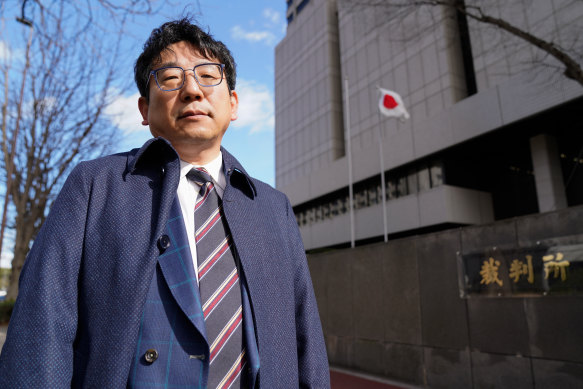
“I want to explain to her that I am here,” Hiroshi Miwa says of his abducted daughter.Credit: Christopher Jue
“This system is evil,” says Hiroshi Miwa, a neurosurgeon from Osaka who has not seen his daughter in six years.
“In so many countries they have a shared custody system and parents do not need to struggle for custody. But in Japan, we have to fight to get single custody, so it causes bigger and bigger conflict.”
“Next year my daughter will enter elementary school, and she will be able to see the parents of her friends. She might have a question: who is my dad? I want to explain to her that I am here. Your father exists.”
Yusuke Shiba did not know his father existed. When he was a year old, his mother and father separated. His mother told him his father had died. It was not until he was 20 that he found out his dad was alive.
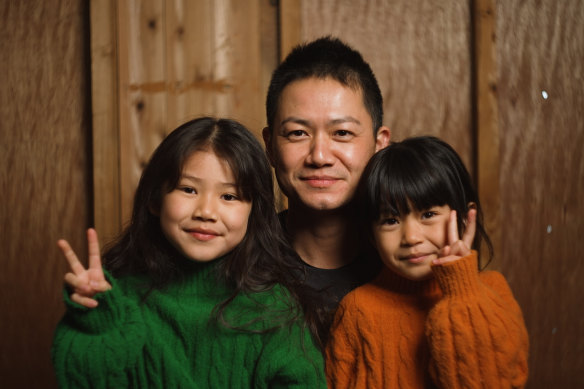
For 20 years, Japanese father-of-two Yusuke Shiba thought his own father was dead.Credit: Jack Donohoe
“I was really, really mad,” the 34-year-old says. “The fact that my mum was able to do this using the Japanese system, it’s wrong.”
It took Shiba more than a decade to process what had happened and find his father. He turned out to be one of Japan’s most renowned string instrument artists, Kakujo Nakamura. Nakamura had done what many Japanese men of his generation did after the end of a relationship: he left and did not look back. That reasoning no longer sits well with Japan’s younger fathers.
“I wanted him to be a grandfather,” says Shiba.
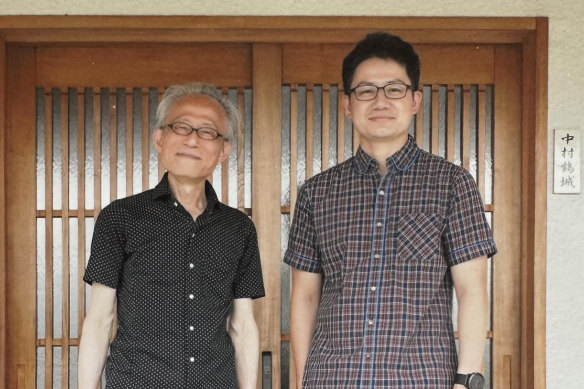
Yusuke Shiba (right) reunited with his father, one of Japan’s most renowned string instrument artists, Kakujo Nakamura, last year.
Those on the other side - the mothers or fathers who have taken children away from their partner - argue the system offers protection from abusive relationships in an under-resourced domestic violence sector.
None of the parents interviewed for this series has had domestic violence charges laid against them, but the issue is significant in Japan, which still has a male-dominated social structure and gendered expectations of women. The situation is complicated by the commission received by Japanese lawyers from child support, creating a commercial incentive to maintain the sole custody system.
That tension has pitted domestic violence shelters, advocates and sole custody lawyers against proponents of joint custody, leaving victims of both stuck in the middle.
In December, Madame Fichot - the Japanese former wife of Vincent Fichot - a French father who held a hunger strike outside in the middle of the Tokyo Olympics, accused joint-custody advocates of demonising her and “sacrificing her human rights”.
French authorities issued an arrest warrant for Madame Fichot after she took her children from France to Japan and disappeared in 2018. In July, a Japanese court ruled that she had sole-parental authority over the kids under Japan’s sole custody laws.
“All I wanted is a safe environment where my children will be able to lead a normal life as much as possible,” she said in a press conference at the Foreign Press Centre of Japan in December.
“He wants to be a nice father, I understand. But to me, he’s not a good father. He wants to put me in jail, and he wants to just raise the kids by himself.”
Hiding in costume to see their children
Navigating this perilous balance between custody and alienation are advocates attempting to bring parents and children back together.
By night Rumi Ozaki messages dozens of desperate parents; by day she smuggles them in to see their children.
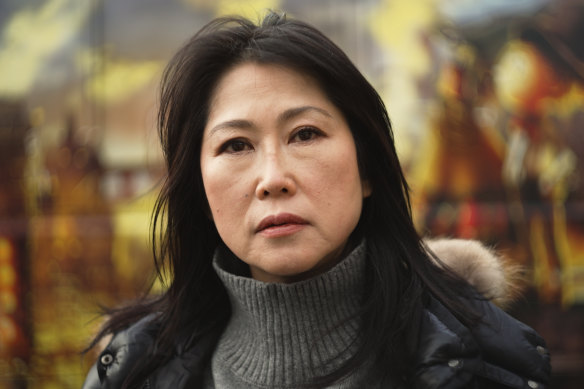
Rumi Ozaki is helping parents see their abducted children.
Ozaki has spent the past four years trying to reunite parents with their kids through elaborate educational exercises.
At schools in Osaka and around the country, Ozaki convinced local authorities to let her park her bus in the school car park. The bus exhibit purported to take kids through a popular Japanese cartoon, The Poupelle of Chimney Town. But hiding inside in costumes of vegetables and rubbish were parents desperate to see their children.
“The parent is dressed in a costume, so they can’t be recognised by their child,” she says, revealing her deception for the first time.
“But for the mum or dad, just seeing their child’s face means everything. Sometimes the children say ‘dad, dad, I know it’s you’. But I say, ‘don’t take off the costume’.”
Scott McIntyre, an Australian father of two abducted kids, says: “That’s how messed up the situation is. You can only say ‘I’m your father’ dressed as a cucumber.”
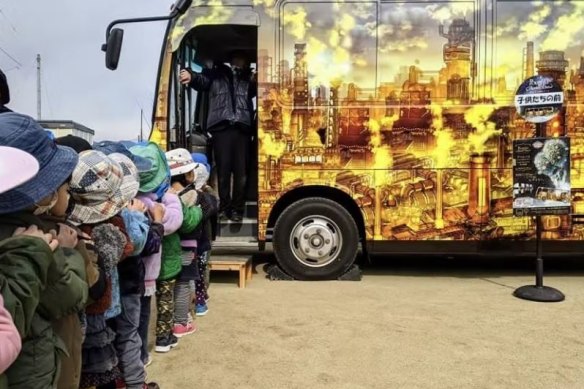
Children wait to enter Rumi Ozaki’s bus exhibit.
Ozaki says her exhibits are illegal.
“But it is so sad. It’s like they are a prisoner inside their outfits. It makes me really, really angry. I can’t close my eyes. I can’t close my ears. And I feel like I need to help.”
A mother stabbed, a father in jail
Inside Tokyo’s largest prison in the northern suburb of Katsushika, Japanese game shows blare on TV. There is a counter selling snacks for inmates as the waiting room fills up with a handful of fathers, mothers, sisters and friends. Each takes a number from the front desk and waits to be sent up to any one of the 12 floors in this high-rise jail that houses inmates on death row.
Jacob Wilson does not get many visitors anymore. He is overweight and covered in dandruff. The American arrived in Japan as a student at Sophia University. He met his future wife and worked for three years in Tokyo. In 2016 they had a son. Then their relationship started to deteriorate.
Now life appears to be draining out of his eyes. Wilson allegedly committed a horrific crime, surrounded by a system that he says broke him.
“I am one of the examples of the family court system,” he says from behind a glass screen in a grey interview cell on the fifth floor of this towering complex in industrial Tokyo, where he is awaiting trial for murder.
In March 2019, he stabbed his wife Kyoko outside the Tokyo Family Court. He killed her after she had taken their son, broken off all contact and assumed sole custody.
“When I tried to seek help the police were unhelpful,” he says. “They laughed at my situation. It was unbelievable that law enforcement was acting like this. I lost all hope.”
Japan’s sole custody advocates argue cases like Wilson’s show the laws are necessary to keep mothers away from violent partners. Critics say it offers no room for mediation, making dangerous situations worse.
Japan’s Ministry of Justice is now reviewing the country’s laws. Wilson’s case shows they can have deadly consequences.
Watch the 60 Minutes report here.
Get a note directly from our foreign correspondents on what’s making headlines around the world. Sign up for the weekly What in the World newsletter here.